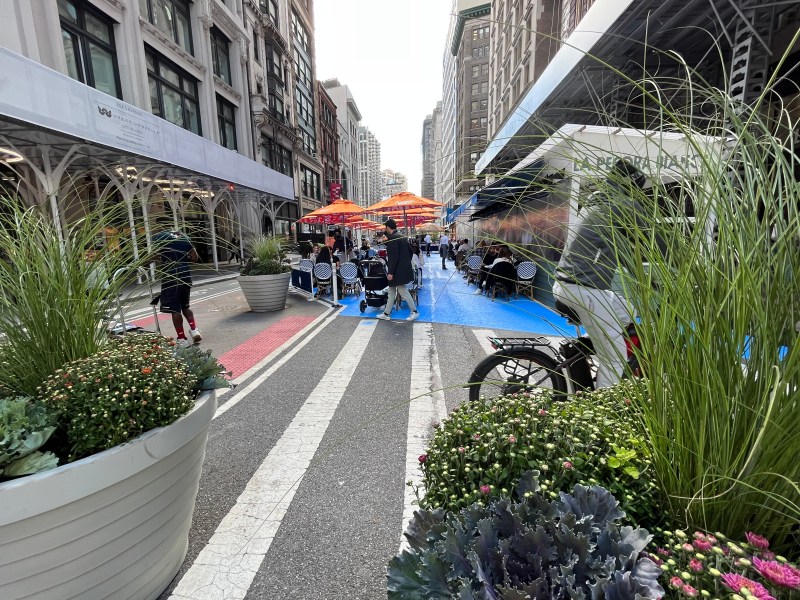Enjoy Another Pedestrianized Part of Broadway — for a Month Only!
A 'pop-up' plaza in the Flatiron District will help restaurants, but safe-streets activists want more.

A month-long “pop-up” plaza that opened this week on Broadway between 25th and 27th streets in the Flatiron District is the latest, incremental and long-delayed step in the city’s plan to make the Great White Way “pedestrian friendly” between Columbus Circle and Union Square.
The so-called NoMad Piazza Pop Up — which allows pedestrians and bicyclists, but prohibits car traffic other than emergency vehicles — features public seating, tables, trees, and planters in the roadbed, which will be cordoned off with granite blocks until the removal of the plaza in early November.
Like other such plazas, the effort, part of the Department of Transportation’s Seasonal Streets program, is being done jointly with a business-improvement district, the Flatiron/23rd Street Partnership, as well as the American Institute of Architects, New York and the urban planning firm Street Plans. The DOT relies on the BIDs to perform routine cleaning, maintenance and public safety, which they do in order to promote local businesses, in this case, the outdoor-dining arrangements of nearby restaurants La Pecora Bianca, The Smith, Num Pang, Tortazo, and wagamama. The Flatiron/23rd Street Partnership also has managed two open streets in the area since May 2020.

The pop up is a tactical-urbanist extension of Broadway Vision, a city program that began during the Bloomberg administration and has been prosecuted fitfully by Mayor de Blasio. The idea, which was to create a 2.5 mile pedestrianized corridor from Columbus Circle to Union Square, started under Mayor Bloomberg with the large-scale pedestrianization of Times and Herald Squares and the creation of the Flatiron Public Plazas near Madison Square. The Broadway Vision projects of the current administration — now nearing the end of an eight-year run in which the city enjoyed some very good times, at least before the pandemic — turned out to be much more modest. The DOT launched a “shared street” (roadways where car drivers are permitted but required to move slowly) on Broadway from 24th to 25th streets in 2017, and a “slow block” (another such arrangement) between 21st and 23rd streets earlier this year.
In January, the Union Square Partnership unveiled a $100-million plan to remove cars from the Union Square-14th Street area and create almost 100,000 more square feet of public space. Even though the plan did not come out of the the DOT, its Manhattan borough commissioner, Ed Pincar, said it “aligns” with Broadway Vision.
A notorious car sewer, Broadway for years has been in the sights of safe-streets activists, who want to pedestrianize the boulevard by eliminating cars between Houston Street on the Lower East Side and Columbia University in Morningside Heights.
Katherine Nessel, the co-lead for Open Broadway campaign of Transportation Alternatives Manhattan Activist Committee, said the plaza is lovely, but saw it as a missed opportunity.
“I biked by the plaza yesterday and was awe struck with the massive difference between these full pedestrian plazas and the streets before,” she said. “While open streets are amazing, they should not be the end game but instead serve as stepping stones toward full pedestrianization. The blue paint, artistic designs, and boulders really transform the streetscape into something fully detached from automobiles and focused on people instead. It would be a shame for this plaza to be taken down so shortly, because it greatly contributes to DOT’s long-term plan of an ‘Open Broadway’ and Transportation Alternatives’s more ambitious goal of a linear park along Broadway.”

In January 2020, a few weeks after de Blasio’s sixth anniversary as mayor, the DOT presented an overview of its strategy for Broadway Vision to Manhattan Community Board 5. The presentation outlined a “toolkit” consisting of “slow blocks,” “shared streets,” and “base blocks” and suggested some “possible configurations,” but follow-up actions did not materialize because of the pandemic. The city’s streetscape has changed greatly since because of COVID, with the open-streets movement, spearheaded by ordinary citizens, liberating blocks for living space, and al-fresco dining, the urgent demand of the restaurant industry that was met with the DOT’s emergency Open Restaurants program.
“This is another wonderful addition to what is becoming the heart of Open Streets along Broadway in Manhattan,” DOT Commissioner Hank Gutman said of the temporary plaza in a statement. “Our fellow New Yorkers are embracing these new open spaces, which are helping to support the restaurant industry while also getting folks out of their cars.”


